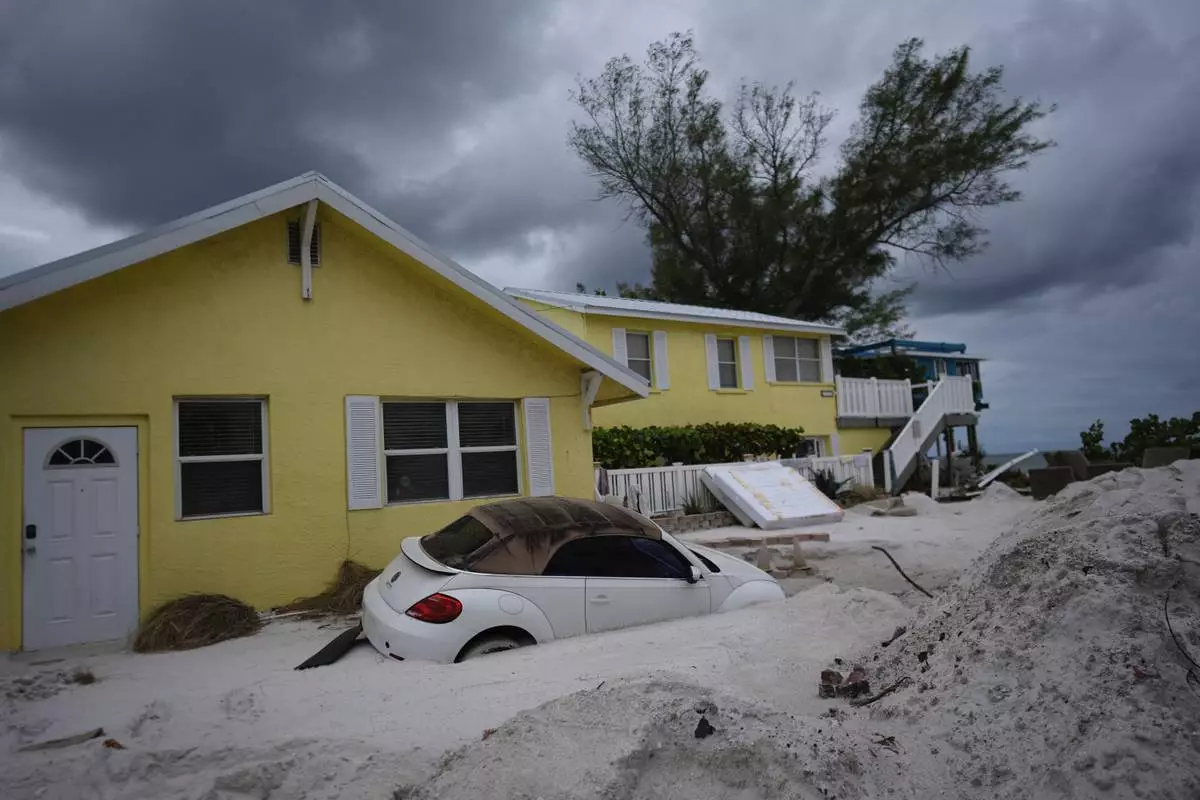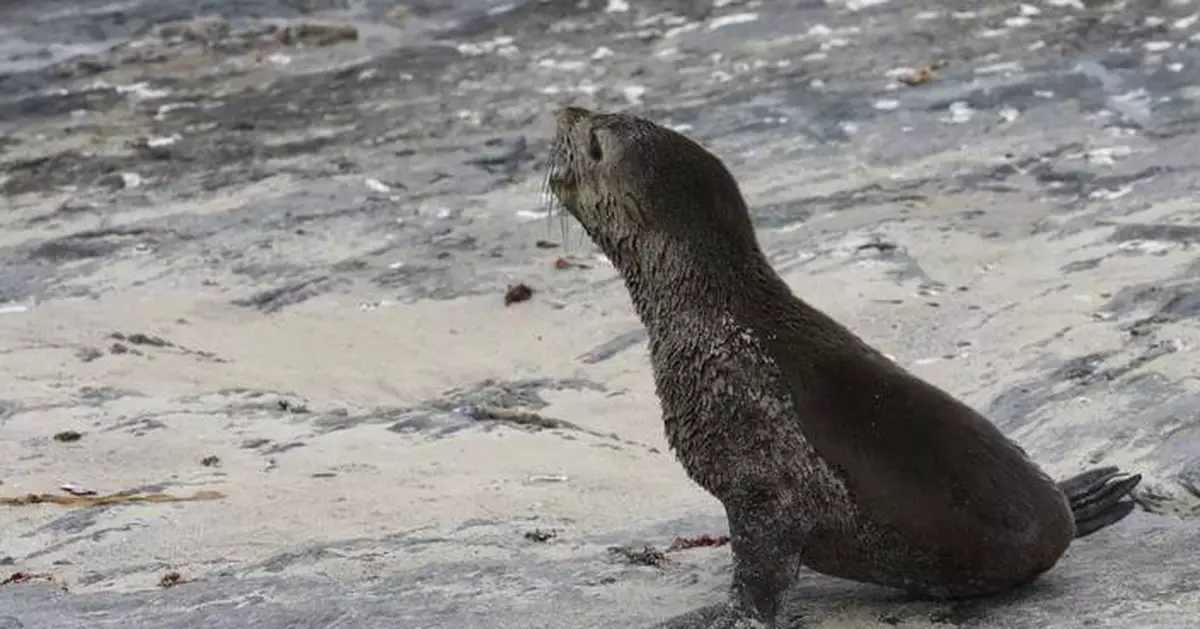CAPE TOWN, South Africa (AP) — Scientists in South Africa say they have identified an outbreak of rabies in seals that is believed to be the first time the virus has spread in sea mammals.
At least 24 Cape fur seals that were found dead or euthanized in various locations on South Africa's west and south coast had rabies, state veterinarian Dr. Lesley van Helden said.
Rabies, which affects mammals and can be passed to people, is almost always fatal once symptoms appear. Rabies spreads via saliva, usually through bites but also sometimes when animals lick and groom each other.
The virus has long been seen in wild animals such as raccoons, coyotes, foxes, jackals and in domestic dogs. But it had never been recorded spreading among marine mammals, van Helden and other experts said this week.
The only other known case of rabies in a sea mammal was in a ringed seal in Norway's Svalbard islands in the early 1980s. That seal had likely been infected by a rabid arctic fox, researchers said, and there was no evidence of rabies spreading among seals there.
Authorities in South Africa first discovered rabies in Cape fur seals in June after a dog was bitten by a seal on a Cape Town beach. The dog became infected with rabies, prompting rabies tests on brain samples from 135 seal carcasses that researchers had already collected since 2021. Around 20 new samples also were collected and more positives have come back on subsequent tests.
Scientists are trying to work out how rabies was passed to the seals, whether it is spreading widely among their large colonies and what can be done to contain it.
“It’s all very, very new," said Greg Hofmeyr, a marine biologist who studies seals in South Africa. “A lot of research is required ... there are a lot of unknowns here.”
There are approximately 2 million seals migrating back and forth between South Africa, Namibia and Angola along Africa's south and west coast. The most likely possibility, van Helden said, is that rabies was first passed onto seals by jackals in Namibia, where the wolf-like animals hunt seal pups on the coastline.
The genes of the rabies virus found in the seals matched the rabies in black-backed jackals in Namibia. It also showed rabies was being transmitted between seals, because most of the virus sequences were closely related, she said.
"So, it’s basically established itself in the seal population and it’s being maintained by them biting each other,” van Helden said.
The seals live in close proximity to people in places in South Africa, especially on beaches around the city of Cape Town. The city has issued warnings to locals, said Gregg Oelofse, Cape Town's head of coastal and environmental management.
Authorities had been mystified for the past three years by reports of excessively aggressive seals and an increase in seal attacks on people, some of whom had been bitten. No human cases of rabies have been recorded as a result.
Oelofse said that city authorities had started vaccinating the small numbers of seals at two popular Cape Town harbors, where they are considered an attraction.
One of the positive rabies tests was on a seal carcass collected in August 2022, meaning rabies had been in the seal population for at least two years, Oelofse said.
“It’s been here for a while longer than we’ve known about it,” he said.
Experts said there were still many unknowns.
It’s hard to predict long-term transmission dynamics, U.S. Centers for Disease Control and Prevention spokesman Dave Daigle said. He noted previous instances of rabies viruses winding up in new hosts and then dying out. In 2021 in the U.S., for example, gray foxes were spreading the raccoon rabies virus variant for two years, and then transmission stopped.
The U.S. public health agency is watching the situation in South Africa, but has yet to see “clear evidence that this is going to be a long-term issue," Daigle said.
Another unknown is if the vaccine will be effective in seals. It's never been tested, but experts think it should work.
There's also a logistical question, van Helden said: How do you vaccinate a significant number of seals that live largely in the ocean and migrate back and forth along a coastline that is more than 3,500 kilometers (2,170 miles) long. Land animals can be vaccinated by dropping bait that releases oral vaccines when eaten, but seals generally will only eat live fish, she noted.
South African officials have been collaborating with international experts.
Seal researcher Hofmeyr said that some other seal species come into contact with Cape fur seals and then travel to other parts of the world and that was a concern for further spread.
"The chances of that happening are very low, but the implications of that if it does happen are very important,” he said.
AP Africa news: https://apnews.com/hub/africa

FILE — People walk past a dead Cape fur seal on Melkbosstrand beach near Cape Town, South Africa, Friday, Nov. 5, 2021. (AP Photo/Nardus Engelbrecht/File)

A Cape fur seal on Seal Island near Cape Town, South Africa, Sunday, Nov. 22, 2020. (AP Photo/Nardus Engelbrecht)

A Cape fur seal on Seal Island near Cape Town, South Africa, Sunday, Nov. 22, 2020. (AP Photo/Nardus Engelbrecht)
WASHINGTON (AP) — Congress is allocating more than $100 billion in emergency aid designed to address extensive damage caused by disasters after this week's scramble to find consensus on a government spending bill.
The money comes after back-to-back hurricanes — Helene and Milton — slammed into the southeastern United States this fall, leaving havoc in their wake. But the money would go to much more than just those two storms under the bill signed Saturday by President Joe Biden that keeps the federal government funded through March 14.
The disaster funding looked set to pass earlier this week until President-elect Donald Trump issued new demands that tanked a compromise and threatened a pre-Christmas federal shutdown. A slimmed-down version cleared Congress early Saturday when Republicans abandoned Trump's core request.
Here's a look at what's in the bill for disaster relief and where the money will go:
The Federal Emergency Management Agency's disaster relief fund is essentially the country's checkbook for emergencies. Out of it, the government reimburses states and local governments for things such as removing debris accumulated after hurricanes or overtime costs for firefighters and police who work during disasters.
It also includes money for individual residents, ranging from the $750 payments that disaster survivors can get to $42,500 that some uninsured homeowners can receive to help them rebuild.
Esther Manheimer, mayor of Asheville, the largest city in the North Carolina mountains that was hard hit by Helene, said city officials were pleased to see th additional disaster dollars.
It’s only been four weeks since Asheville residents could drink from and bathe in the water coming out of their faucets. Some businesses in western North Carolina have shuttered permanently or are struggling to survive, and well over 200 roads in the region remain closed.
In a statement earlier in the week, Manheimer emphasized that it was still going to be a long recovery and that "already we see the long-term economic, budgetary and employment impact Helene left in her wake.”
The disaster relief fund was nearly running on fumes after Helene and Milton. FEMA Administrator Deanne Criswell warned during a Senate hearing in November that the fund was down to $5 billion.
The Biden administration had asked Congress for about $40 billion for the relief fund but the bill eventually passed provides a lower amount, $29 billion.
It’s important to keep in mind that this isn’t the only money for the disaster relief fund, said Stan Gimont, a senior adviser for community recovery at Hagerty Consulting. He used to run the community development block grant program at the Department of Housing and Urban Development.
More money can and likely will be designated to the fund later when Congress does a full-year appropriation, he said.
There's also about $21 billion in disaster assistance to help farmers.
North Carolina Agriculture Commissioner Steve Troxler said earlier this week that he was pleased by the agricultural aid but that the state has a lot of specialty crops such as sweet potatoes and Christmas trees that are generally not covered by federal programs. He said he will have to wait and see what specifically ends up being covered.
“We are still evaluating the bill as there are a lot of nuances in it. The devil is in the details," he said.
Other money will go toward rebuilding damaged roads and highways ($8 billion), while more money (about $12 billion) would go toward helping communities recover through HUD grants.
The block grant money is one of the key funds for homeowners who don’t have insurance or enough insurance to recover from disasters.
There’s also $2.2 billion for low-interest loans for businesses, nonprofits and homeowners trying to rebuild after a disaster.
But the money doesn't go just toward local residents.
For example, there's money for the military to address damage from hurricanes and typhoons and for a new hurricane hunter — the planes used to research hurricanes — and funds to help NASA rebuild hurricane-damaged facilities.
No. The money goes to cover more than those two disasters.
Some of the money is specifically earmarked for certain projects such as $1.5 billion designated for assistance after the largest wildfire in New Mexico’s recorded history — the Hermit’s Peak/Calf Canyon fire — and the rebuilding of the Francis Scott Key Bridge in Baltimore.
But a lot of the money also goes more generally toward major disasters that happened in recent years.
The types of disasters covered in the legislation include droughts, wildfires, hurricanes, floods, derechos, and smoke exposure.
Gimont points out that disaster recovery can take a long time so the country is both paying for disasters that happened previously while it prepares for events that will happen in the future.
Take the massive Maui fire, for instance. It decimated the Hawaiian town of Lahaina last year, but Gimont said just the cleanup itself extended into late summer 2024.
Loller reported from Nashville, Tennessee.

FILE- North Carolina Gov. Roy Cooper, right, and Deanne Criswell, Administrator of the U.S. Federal Emergency Management Agency, await the arrival of Democratic presidential nominee Vice President Kamala Harris for a briefing on the damage from Hurricane Helene, at Charlotte Douglas International Airport, in Charlotte, N.C., Oct. 5, 2024. (AP Photo/Chris Carlson, File)

FILE - Michael Vierra looks at his house after it was destroyed by a wildfire, in Lahaina, Hawaii, Sept. 26, 2023. Authorities in Maui strongly encouraged homeowners to wear protective gear provided by nonprofit groups when visiting their properties to protect against asbestos, lead and other toxic remains of the wildfire. (AP Photo/Mengshin Lin, File)

FILE - Homes consumed in wildfires are seen in Lahaina, Maui, Hawaii, Aug. 16, 2023. (AP Photo/Jae C. Hong, File)

FILE - As Hurricane Milton approaches, a car sits half-buried in sand in Bradenton Beach, Fla., in the aftermath of Hurricane Helene, Oct. 8, 2024. (AP Photo/Rebecca Blackwell, File)

FILE - This photo provided by the North Carolina Department of Transportation shows the collapsed eastbound lane of I-40 into the Pigeon River in North Carolina near the Tennessee border, Sept. 28, 2024. (N.C. Department of Transportation via AP, File)

FILE - A man walks near a flooded area near the Swannanoa river, effects from Hurricane Helene , Friday, Sept. 27, 2024, in Asheville, N.C. (AP Photo/Erik Verduzco, File)

FILE - Ben Phillips, left, and his wife Becca Phillips scrape mud out of their living room in the aftermath of Hurricane Helene, in Marshall, N.C., Oct. 1, 2024. (AP Photo/Jeff Roberson, File)

FILE - Damage from Hurricane Helene near Asheville, N.C., is seen during an aerial tour for President Joe Biden, Oct. 2, 2024. (AP Photo/Susan Walsh, File)




















